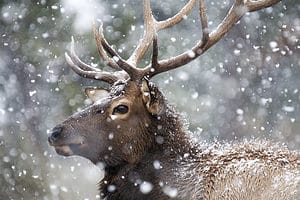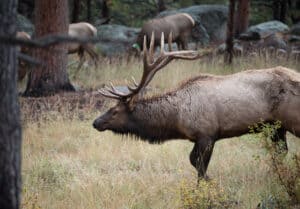One word that aptly describes the elk is magnificent. The animal is huge, sometimes reaching heights of up to 9 feet tall. But its true splendor is from its antlers that extend up to 1,100 pounds. If you do a cursory internet search about elks, you’ll find interesting, little-known facts about them. One of the most common is that people tend to mistake it for the moose. That in itself is explainable because they do look alike.
The male elks are also like that loud sibling who always manages to outspeak others. Interestingly, males are the loudest when trying to attract female partners.
The elk is also a game favorite for hunters. Let’s find out about the largest American elk ever caught in Texas. But first, let’s explore this fascinating mammal in more detail.
Elk, What Are They?
The scientific name for the elk is Cervus eephus canadensis, but you’ll also find reference to it as the wapiti. It’s an advanced subspecies of red deer commonly found in central Asia and North America.
The name elk comes from a Germanic root word for hart or stag. The English settlers gave the native red deer species the name. Later the adaptation of the term spread to New England and other areas.
Other people referred to the elk as wapiti, which translates to ‘White’ deer in the Shawnee language. The Shawnee is an Algonquian language spoken by the Shawnee people from the Eastern United States. It was a common language in Ohio River Valley and its surrounding areas. Unfortunately, over time, the use of the language has dwindled, and only a few Shawnee Oklahoma natives speak it.
The Shawnee got the wapiti name from the light coloring of the bull elk. Despite the occasional reference to the elk as wapiti, the name never took root outside the Shawnee people. Indeed many wouldn’t be able to identify which animal you are talking about if you referred to the elk as wapiti.
Elk populations were present in the northern hemisphere, specifically Europe, Northern Africa, North America, and Asia. Over-hunting in North America significantly led to a decline in elk populations. However, parts of Canada, the Eastern Rockies, New Mexico, and the northern peninsula of Michigan have significant elk numbers.
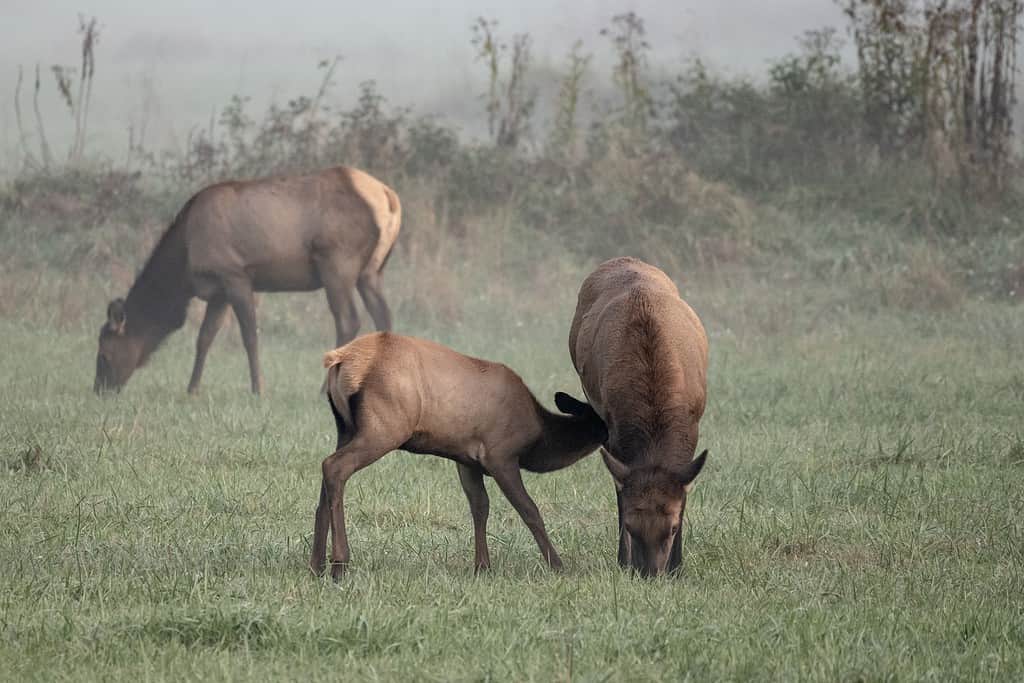
Elk calves rely on their mothers for milk during the first few months and later transition to solid food.
©Kelly vanDellen/Shutterstock.com
Elk in Texas
The first sighting of elk populations in Texas was around 1601 by the New Mexico governor Don Juan de Onate. His description of the animal combined horse-like and deer-like features. After that, other people continued to see the elk in the Rio Grande Valley and Panhandle. That gave some level of affirmation that elk were indeed Texas natives. Commercial and sport hunting almost led to the extinction of the elk, whose numbers significantly dwindled in the 20th century.
Currently, you’ll find Elk populations in West Texas, specifically:-
- Glass Mountain
- Guadalupe Mountain
- Wiley Mountain
- Davis Mountain
- Eagle Mountain
The number of living elk within these areas is about 2,000.
Elk Appearance
The elk has a distinctive brown or reddish coat that tends to get lighter towards the neck and rump. Together with that is a dark brown mane on the neck and a pale patch on the rump.
The antlers are quite fascinating due to their sheer size. In adult males or bucks, the tip-to-tip measurement of the antlers can reach 1.5 meters. It’s worth noting that females don’t grow antlers.
The antlers branch off into multiple points, almost resembling tree branches. Even more interesting is that the elks shed and regrow their antlers yearly. At this point, you’re probably wondering how this is possible. Well, the antlers can grow at an impressive 2.5 cm daily. The rapid growth is testosterone-driven. During late winter, a significant decline in the hormone makes the antlers drop off, and the growth cycle begins again.
In winter, the coat can grow quite long. The waterproof hairs keep the wooly underfur dry, thus ensuring it remains warm during cold days. As summer approaches, the elk will rub against trees to eliminate the excess hair.
A side-by-side comparison of the elk and moose will show you that the latter is bigger. That’s usually one point of distinction for those who know the two animals. Large males can tip the scales at almost 1,000 pounds. Female elk are generally smaller, with the heaviest being about 644 pounds. However, you’ll find variations amongst the 14 subspecies.
Elks don’t have the most graceful-looking body. The trunk is thick, with a short tail and a defined body; their slender legs don’t look like they can handle the combined weight of the massive body and antlers. It almost looks like child-like drawings of animals. The nose-to-tail length can reach nearly 9 feet.
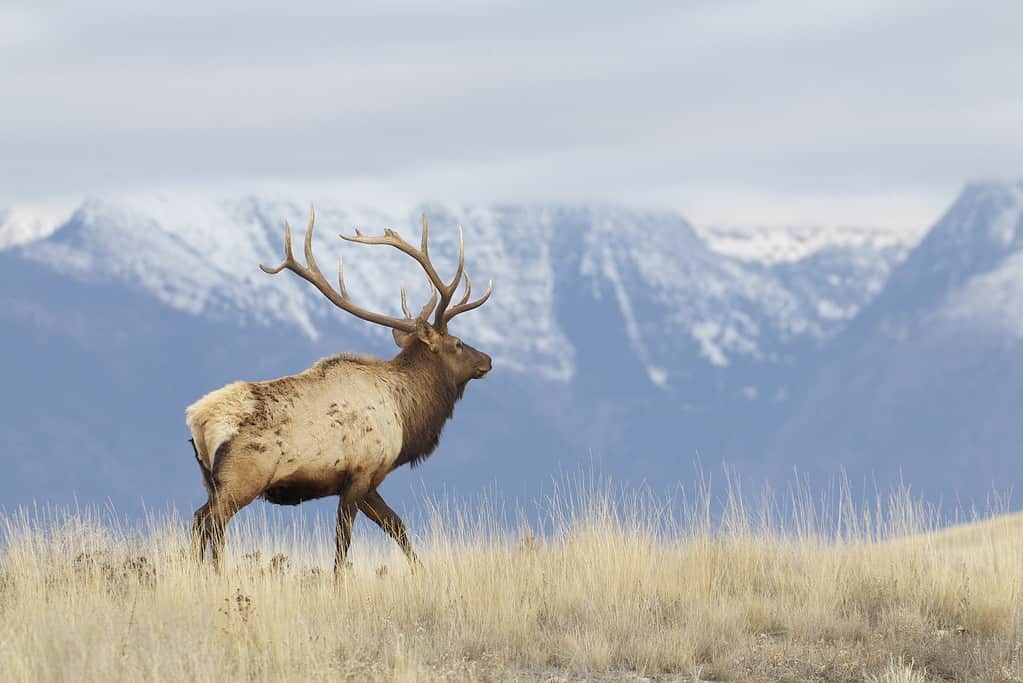
This majestic bull elk stands watch over his harem, exhibiting the distinct physical characteristics of males of the species.
©Tom Reichner/Shutterstock.com
Elk Habitat and Feeding Habits
The elks are hardy herbivores and will adapt to any habitat that has their food. That makes them common in alpine meadows, grasslands, and forests.
The elk’s food choices include shrubs, trees, grasses, and forbs. Tree bark also comes to their rescue during winter. On average, an elk can eat about 20 pounds of vegetation daily. It makes sense, though, if you look at how much body weight they have to sustain.
Their choice of habitation is also critical for their survival from predators and harsh weather conditions. Access to water is also essential, and the elk will look for areas with rivers, streams, or other water sources.
Grazing happens all day, from morning to evening. The elk will only partially chew the food before swallowing. The food goes to the rumen or a specialized holding stomach. Microorganisms and bacteria father break down their food into what we call cud. At night, the elk will regurgitate the cud for further chewing in a process called rumination.
The elk can be selfish when it comes to satisfying its needs. As social animals, they tend to live in large herds, sometimes reaching 400 – imagine how much roaming area they need. Males and females will live apart in different herds. Like humans, females, including young bulls, tend to have more family around them.
Males fall into two categories: the dominant stud with harems of 20 or more females and the shy, awkward elk who resembles that awkward guy at the prom; you know, the one who can’t muster the courage to ask the pretty girl to dance? Sometimes the less dominant bucks may try to challenge the stud, but fierce fighting results.
Elk Mating and Breeding Patterns
The elk mating season is worth a front-seat viewing at a binge show. The ostentatious display of might is quite fascinating. The competition for female attention amongst the bulls can get loud and messy.
The rutting behavior includes antler displays and antler wrestling, and then there’s the free for all peeing. The males urinate on the ground and roll in it. That is the most natural, female-attracting smell they can muster up.
And the wooing does not stop with the pee-drenched coat. There’s the boggling or vocalization, which gets loud. Imagine 4000 Hz or a high-pitched 150 Hz sound hitting the females from all the wanna-be baby fathers.
So here is how the boggling sounds. It starts cool with a deep and resonant note which then escalates to a high-pitched squeal which then tapers down to a succession of grunts. Hearing it for the first time is haunting, and the hairs at the back of your neck will rise.
Reproductive maturity starts at about 16 months of age. The mating season is from late August to early winter. The stud has his pick of ready females and can mate with as many as possible.
The gestation period is about 240 to 262 days resulting in one, sometimes but rarely two offspring. A calf can weigh up to 440 pounds at birth. The motherly instinct in cows is quite strong, as they will isolate just before and after giving birth; this provides an excellent opportunity to keep the calves safe from the many predators. After about two months, the calf is off the mother’s milk and can feed like the rest.
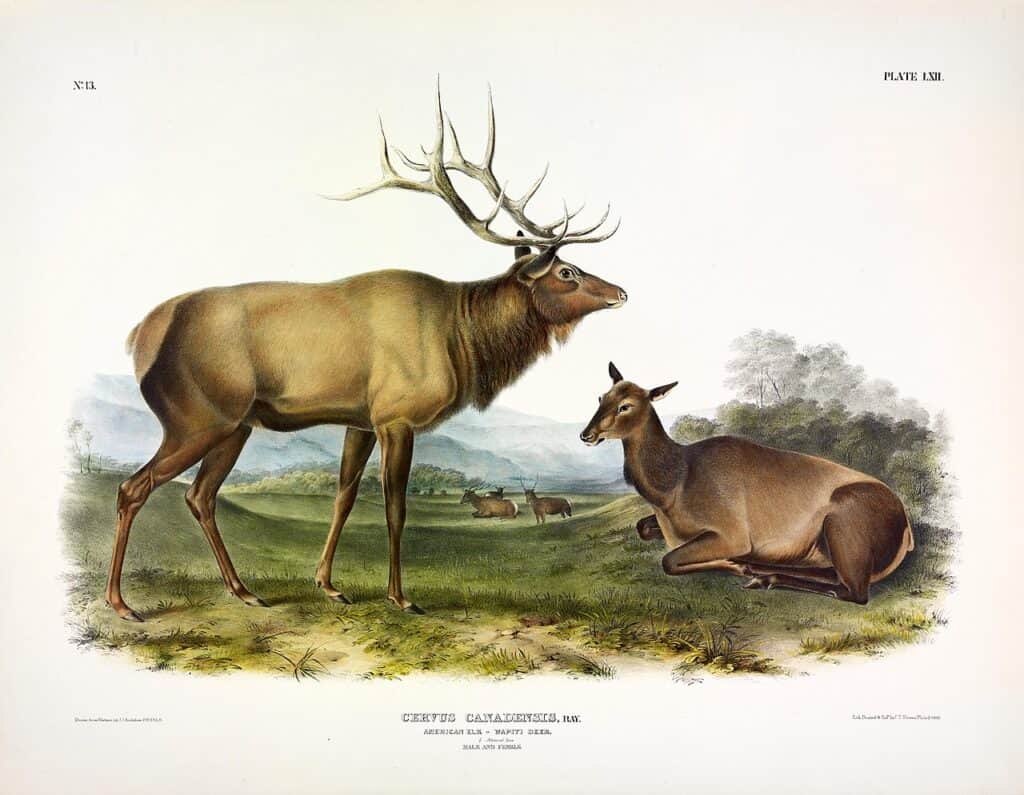
During mating season, the bulls will bellow their loud call to attract a mate and establish dominance over other males.
Are Elk Dangerous?
Let’s start by saying elk are wild animals, and you should give them respect and distance yourself from them as you would any other animal of that nature. No matter how docile or friendly they look, the animal is not domesticated or socialized with human beings.
That said, elk don’t fall into the dangerous-to-humans category. But you can be sure that the elk aggression will come out if they feel you’re threatening their peace or existence. You should also be extremely careful during mating season, as the males can be incredibly aggressive. Remember, they’re in the process of wooing females and may change if you get close. Also, avoid coming between a cow and her calves. The Instinct to protect the little one can bring out some aggression.
Elks are agitated when they flare their nostrils, lift their head, and lay back their ears. An extra sign is punching the ground with their front hooves.
If you bump into an elk, try and give it space. Avoid any sudden movements so as not to startle it.
Hunting Regulations Governing Elk Hunting In Texas
You can hunt elks all year round in Texas. You’ll need a license, which is available on the Texas Parks and Wildlife Department (TPWD) online portal or over the counter.
Unfortunately, due to its exotic classification, the state does not protect the animals from excessive hunting. So what does this mean? The TPWD controls animal species populations by imposing hunting seasons and bag limits per hunter. Animals falling into the exotic species have no such limitations.
Elk hunters have free rein to go about their business without restriction at any time of the year. They can also kill as many elk as they wish without having to report to TPWD. Even during mating season, hunters can go about their business without restriction. There’s also no limitation on weaponry, so you can use archery or firearms if you wish.
The elk classification as exotic has drawn much criticism from animal rights activists. The label means a whole animal species can face eradication without the government’s protection. The direct result is a loss of genetic diversity, species extinction, and destruction of ecosystems and wildlife habitats.
The exotic label also creates loopholes around animal welfare laws. Trophy hunters or gaming farms can mistreat and exploit the animals and avoid penalties due to ambiguous loopholes. A change in the legislature will lead to the declassification of elks back to the animals that enjoy protection against excessive hunting.
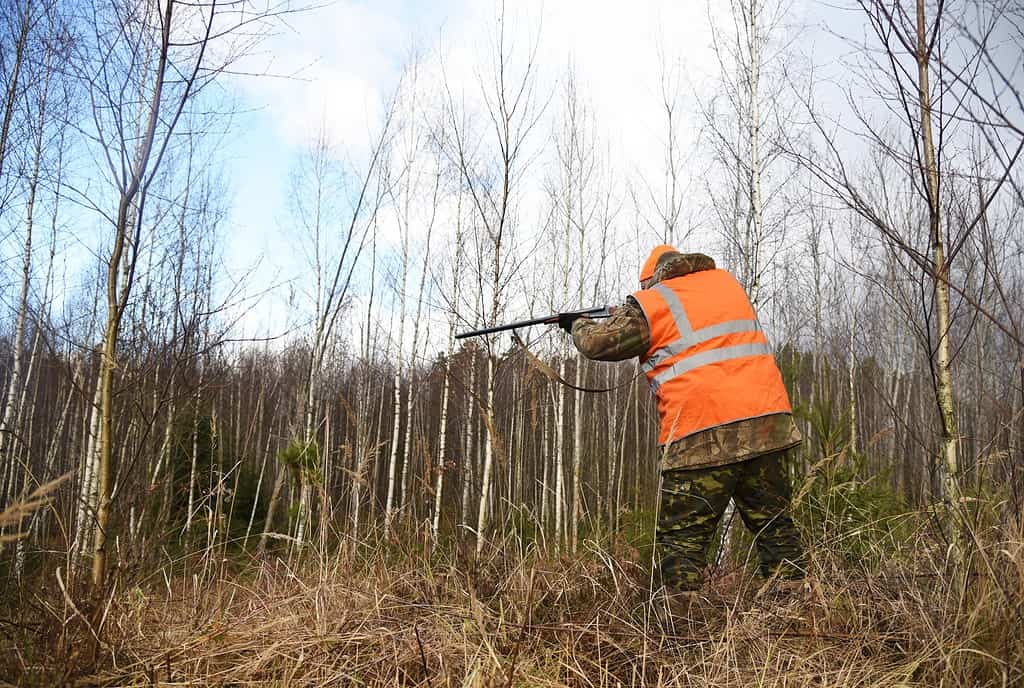
Elk hunting is an important tradition that helps maintain the health and balance of wildlife populations.
©Maksim Safaniuk/Shutterstock.com
Why Is Elk Hunting So Popular In Texas
The reasons for the popularity of elk hunting in Texas are many, including:-
- The challenge of going up against a mentally and physically challenging opponent is exciting. Hunting elks is quite a task because of how fast they are. The ungulates also have a keen sense of smell and hearing. That means they can detect hunters from a distance and take off.
- Elk meat is flavorful, lean, and somewhat similar to beef but a bit sweeter. For the best cuts, calves are more tender. As you can imagine, the older the elk, the tougher the meat. Indigenous North Americans, since prehistoric times, have hunted and consumed elk. The same applies to Asia and Europe, where elk beef was a staple to some.
- There are no restrictions on elk hunting in Texas. The abundance of hunting ranches and wild, free-range elk provides plenty of game for hunters.
- The management of the elk populations through hunting also significantly contributes to the sport’s popularity.
- Trophy hunters love the impressive antlers for display purposes.
- The social aspect of hunting while spending time with loved ones and experiencing nature together makes the sport quite popular.
Largest Elk Ever Caught In Texas
There isn’t any actual confirmation on the largest elk ever caught in Texas. There’s also a lack of a distinction on what the largest elk means. Are you measuring the antlers or body size? A hunter would go for the rack size.
An internet search shows that the record may belong to Kyle Bauer in 2010. The hunting expedition was at the last Catarin Ranch in Kerr County. The lodge owner and guide Aaron Bulkley and his team had named the elk the ‘Lightning Bull.’
The Trophy Game Records and SCI took measurements, which came in at almost 505 inches. Since the hunting was at a ranch, the hunter can’t take credit for the largest wild elk ever caught. But Kyle can continue to hold the distinction until someone comes forth with new claims.
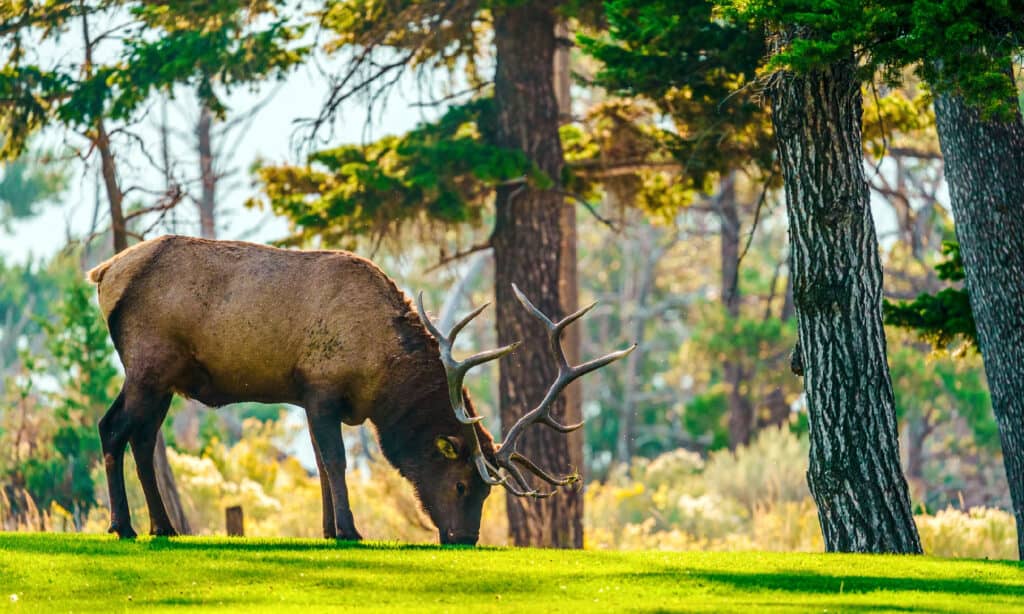
A majestic elk stands, gracefully grazing in a lush green field, its antlers reaching far against the blue sky.
©iStock.com/FluidMediaFactory
Where is Kerr County, Texas, Located on a Map?
Kerr County, Texas, is a county located in the state of Texas, USA. It is situated in the central part of the state and borders several other counties, including Bandera County to the west, Kendall County to the east, Gillespie County to the north, and Kimble County to the south.
Getting specific directions on how to reach Kerr County from your current location would depend on where you are starting from. However, if you are driving from San Antonio (which is approximately 60 miles southeast of Kerrville -the main city in Kerr County), take Interstate 10 West towards El Paso for about 50 miles. Then take Exit 505 onto Highway 16 North towards Fredericksburg/Kerrville. Continue for about another 25 miles until you reach downtown Kerrville.
There’s So Much to Know about the Magnificent Elk
The elk is an imposing creature that’s a sight to behold. The peaceful animals spend their days grazing and nights ruminating. How much better would life be without predators and hunters on their tails?
Texas allows for elk hunting all year with no restrictions on exotic animals. But you must still apply for a license and observe any other regulations.
The photo featured at the top of this post is © iStock.com/Eric Clark
Thank you for reading! Have some feedback for us? Contact the AZ Animals editorial team.





